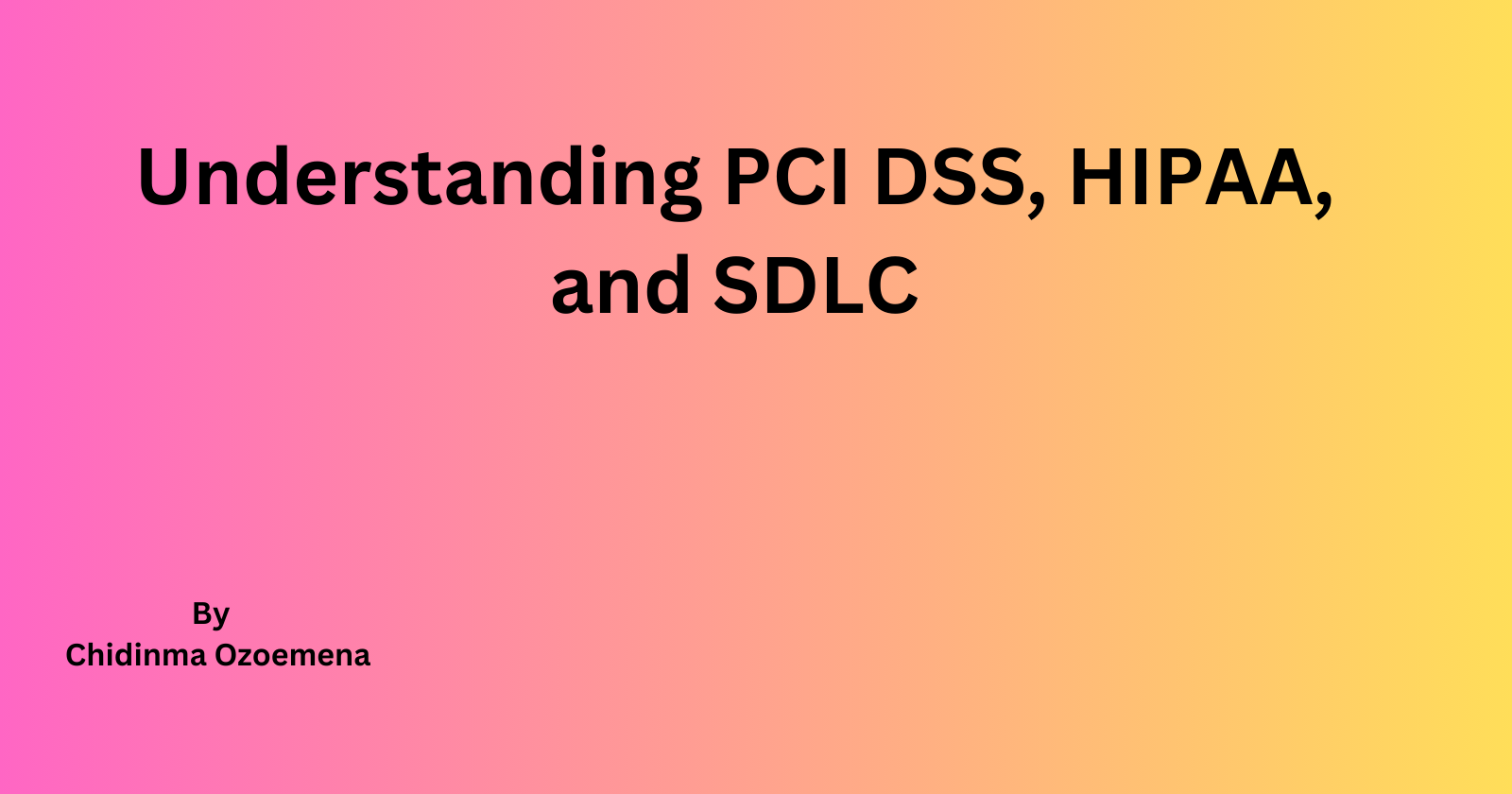Understanding PCI DSS, HIPAA, and SDLC
 Chidinma Ozoemena
Chidinma Ozoemena
PCI DSS (Payment Card Industry Data Security Standard)
PCI DSS is a set of security standards designed to ensure that all companies that handle credit card information maintain a secure environment. These standards were established by the Payment Card Industry Security Standards Council (PCI SSC) to enhance security and mitigate credit card fraud. The standards apply to any organization that accepts, processes, stores, or transmits credit card information, including retailers, online merchants, and payment processors.
Key Requirements of PCI DSS:
Build and Maintain a Secure Network:
Install and maintain a firewall configuration to protect cardholder data.
Do not use vendor-supplied defaults for system passwords and other security parameters.
Protect Cardholder Data:
Protect stored cardholder data.
Encrypt transmission of cardholder data across open, public networks.
Maintain a Vulnerability Management Program:
Use and regularly update anti-virus software.
Develop and maintain secure systems and applications.
Implement Strong Access Control Measures:
Restrict access to cardholder data by business need-to-know.
Assign a unique ID to each person with computer access.
Regularly Monitor and Test Networks:
Track and monitor all access to network resources and cardholder data.
Regularly test security systems and processes.
Maintain an Information Security Policy:
- Maintain a policy that addresses information security for all personnel.
Example: A retail company that processes credit card transactions must comply with PCI DSS to ensure customer payment information is secure. This includes encrypting customer data during transmission and regularly testing security systems to prevent unauthorized access.
HIPAA (Health Insurance Portability and Accountability Act)
HIPAA is a US federal law enacted in 1996 to provide data privacy and security provisions for safeguarding medical information. HIPAA applies to healthcare providers, health plans, healthcare clearinghouses, and business associates that handle protected health information (PHI).
Key Components of HIPAA:
Privacy Rule:
Establishes national standards for the protection of individually identifiable health information.
Grants patients rights over their health information, including rights to examine and obtain a copy of their health records and request corrections.
Security Rule:
Sets standards for the security of electronic protected health information (ePHI).
Requires appropriate administrative, physical, and technical safeguards to ensure the confidentiality, integrity, and security of ePHI.
Breach Notification Rule:
- Requires covered entities to notify affected individuals, the Department of Health and Human Services (HHS), and, in some cases, the media of a breach of unsecured PHI.
Enforcement Rule:
- Provides standards for the enforcement of all HIPAA Administrative Simplification Rules.
Example: A hospital must comply with HIPAA regulations to protect patient records and ensure that only authorized personnel can access them. This includes implementing access controls, encrypting electronic health records, and providing training to staff on privacy practices.
SDLC (Software Development Life Cycle)
SDLC is a process used by software development teams to design, develop, and test high-quality software. The SDLC outlines the various stages involved in software development, from initial planning to deployment and maintenance.
Key Phases of SDLC:
Planning:
Define project goals, scope, and constraints.
Conduct a feasibility study and allocate resources.
Requirements Analysis:
Gather and analyze user requirements.
Document functional and non-functional requirements.
Design:
Create system architecture and design specifications.
Develop data models, interface designs, and system layouts.
Implementation:
Write and compile the source code.
Develop software components and integrate them into the system.
Testing:
Perform unit testing, integration testing, system testing, and acceptance testing.
Identify and fix defects to ensure the software meets user requirements.
Deployment:
Deploy the software to the production environment.
Provide user training and support.
Maintenance:
Monitor the software for issues and perform necessary updates.
Implement enhancements and ensure ongoing performance.
Example: A software company developing a new application will follow the SDLC to ensure the product is built efficiently and meets user requirements. This involves planning the project, gathering requirements, designing the system, writing the code, testing the software, deploying it to users, and maintaining it over time.
Understanding these frameworks and standards is crucial for ensuring the security and efficiency of various processes in both the healthcare and payment industries, as well as in software development. If you have any more questions or need further details, feel free
Subscribe to my newsletter
Read articles from Chidinma Ozoemena directly inside your inbox. Subscribe to the newsletter, and don't miss out.
Written by

Chidinma Ozoemena
Chidinma Ozoemena
Hey there! 😊 I’m a Cloud Security & DevOps Engineer who loves tinkering with Azure, GCP, and AWS. Always eager to learn and share, I’m here to make the cloud a safer place